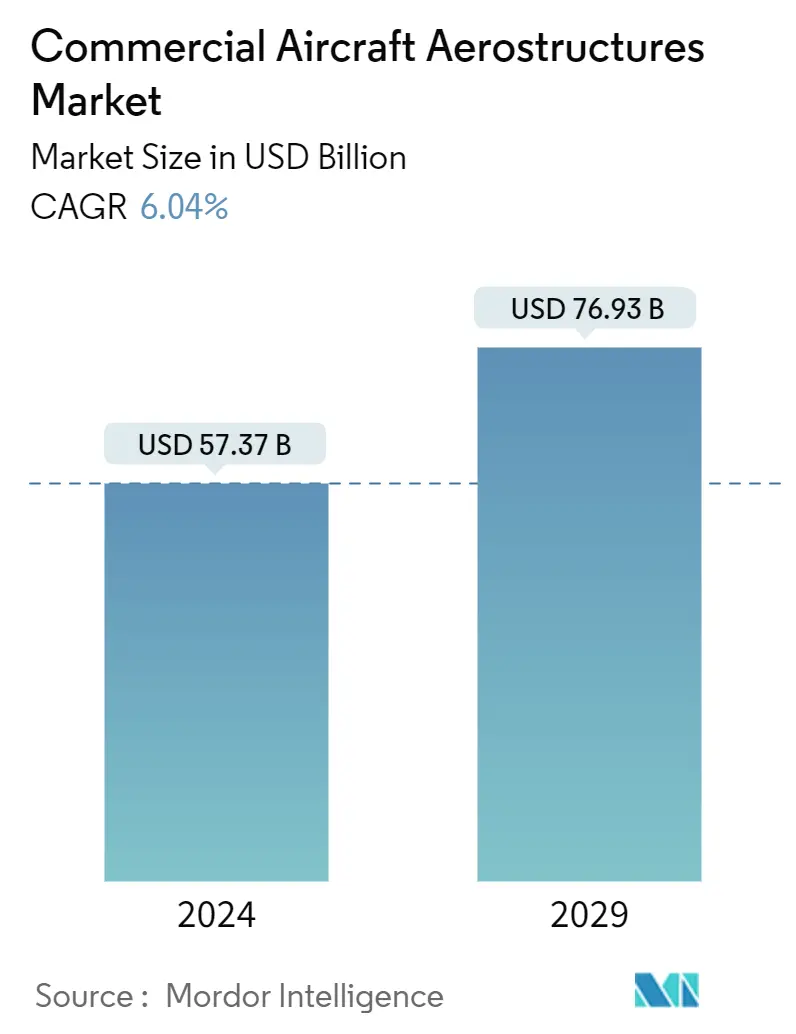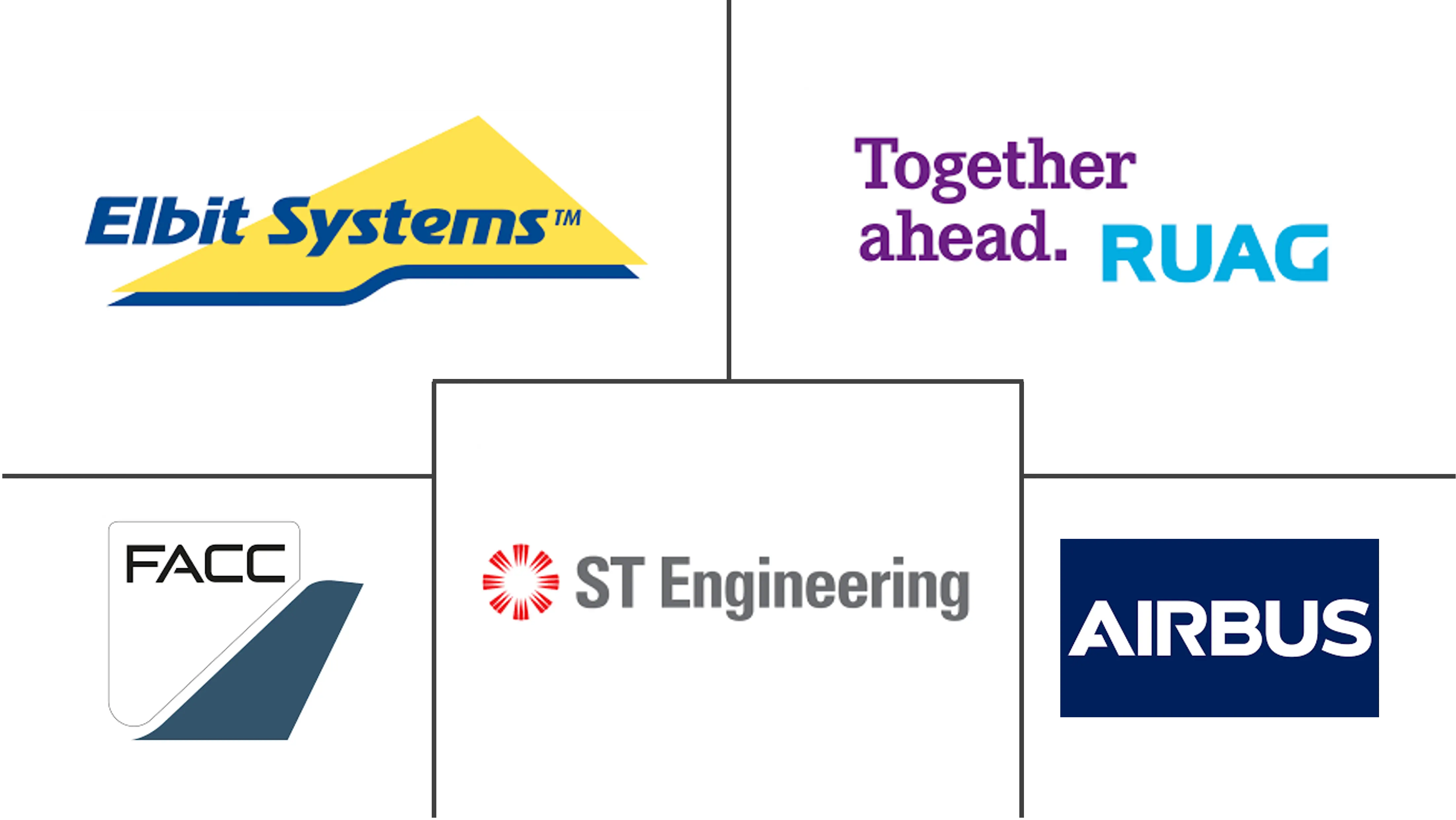Market Size of Commercial Aircraft Aerostructures Industry

| Study Period | 2019 - 2029 |
| Market Size (2024) | USD 57.37 Billion |
| Market Size (2029) | USD 76.93 Billion |
| CAGR (2024 - 2029) | 6.04 % |
| Fastest Growing Market | Asia Pacific |
| Largest Market | North America |
Major Players
*Disclaimer: Major Players sorted in no particular order |
Commercial Aircraft Aerostructures Market Analysis
The Commercial Aircraft Aerostructures Market size is estimated at USD 57.37 billion in 2024, and is expected to reach USD 76.93 billion by 2029, growing at a CAGR of 6.04% during the forecast period (2024-2029).
The main driver for growth in the aircraft aerostructure market is increasing deliveries of commercial aircraft all over the world. The commercial aviation industry saw a significant increase in the number of new aircraft deployed. It is helping to support growth in the global aerostructure market as passengers have become more flexible over recent years. The use of composites and other advanced materials in aerostructures led to radical design changes in aircraft design. Their inherent high strength-to-weight ratio resulted in significant weight savings, thereby enhancing the fuel efficiency of the aircraft.
The market's growth is also due to an increase in tourism at the domestic and international levels, together with strict government rules on air safety.
However, the remuneration scope of the aeronautic sector is hindered by volatility in raw material prices. Technological innovations in the field, growing research & development investments in the aviation industry, and rising efforts of market players to develop advanced product ranges are adding traction to the industry expansion. Emerging technologies such as additive manufacturing and Automated Fiber Placement (AFP) techniques enhance the scope of integrating advanced materials into complex component designs while reducing the aircraft's turnaround time (TAT).
Commercial Aircraft Aerostructures Industry Segmentation
The term aerostructures encompasses all the structural components of an airframe. Aerostructures are required to withstand extreme conditions, ranging from prolonged exposure to extreme temperature variations, foreign object impact, and structural fatigue due to extreme loading cycles. Any aerostructure is an assembly of several structural members constructed primarily from either or all the following materials: alloys, metals, and composites.
The commercial aircraft aerostructures market is segmented by material, end-user, and geography. The commercial aircraft aerostructures market is segmented by material into alloys, composites, and metals. By end-user, the market is segmented into OEMs and aftermarkets. The report also covers the market sizes and forecasts for the commercial aircraft aerostructures market in major countries across different regions. For each segment, the market size is provided in terms of value (USD).
| Material | |
| Alloys | |
| Composites | |
| Metals |
| End-user | |
| OEMs | |
| Aftermarket |
| Geography | ||||||||
| ||||||||
| ||||||||
| ||||||||
| ||||||||
|
Commercial Aircraft Aerostructures Market Size Summary
The commercial aircraft aerostructures market is poised for significant growth, driven by the increasing deliveries of commercial aircraft globally. This expansion is supported by the rising demand for air travel, both domestically and internationally, and stringent government regulations on air safety. The industry is experiencing a transformation due to the integration of advanced materials like composites, which have led to innovative design changes and improved fuel efficiency through weight reduction. Technological advancements such as additive manufacturing and Automated Fiber Placement techniques are further enhancing the market's potential by enabling the incorporation of sophisticated materials into complex designs, thereby reducing aircraft turnaround times. However, the market faces challenges from fluctuating raw material prices, which can impact profitability.
The market landscape is characterized by a fragmented structure with the emergence of new players offering comprehensive lifecycle support, including design, testing, and regulatory compliance. Major aircraft manufacturers are expanding their production capabilities, particularly in the Asia-Pacific region, where economic growth and favorable demographics are driving increased air passenger traffic. This region is expected to see a steady rise in aircraft demand, with countries like China and India projected to become leading aviation markets. Collaborations and partnerships among industry players, such as those between Airbus and local suppliers in South Korea, are strengthening the supply chain and production infrastructure. Additionally, strategic agreements, like those between Magellan Aerospace and Collins Aerospace, are enhancing the production of critical components, supporting the market's growth trajectory.
Commercial Aircraft Aerostructures Market Size - Table of Contents
-
1. MARKET DYNAMICS
-
1.1 Market Overview
-
1.2 Market Drivers
-
1.3 Market Restraints
-
1.4 Industry Attractiveness - Porter's Five Forces Analysis
-
1.4.1 Bargaining Power of Suppliers
-
1.4.2 Bargaining Power of Buyers/Consumers
-
1.4.3 Threat of New Entrants
-
1.4.4 Threat of Substitute Products
-
1.4.5 Intensity of Competitive Rivalry
-
-
-
2. MARKET SEGMENTATION
-
2.1 Material
-
2.1.1 Alloys
-
2.1.2 Composites
-
2.1.3 Metals
-
-
2.2 End-user
-
2.2.1 OEMs
-
2.2.2 Aftermarket
-
-
2.3 Geography
-
2.3.1 North America
-
2.3.1.1 United States
-
2.3.1.2 Canada
-
-
2.3.2 Europe
-
2.3.2.1 Germany
-
2.3.2.2 United Kingdom
-
2.3.2.3 France
-
2.3.2.4 Italy
-
2.3.2.5 Russia
-
2.3.2.6 Rest of Europe
-
-
2.3.3 Asia Pacific
-
2.3.3.1 China
-
2.3.3.2 India
-
2.3.3.3 Japan
-
2.3.3.4 South Korea
-
2.3.3.5 Australia
-
2.3.3.6 Rest of Asia-Pacific
-
-
2.3.4 Latin America
-
2.3.4.1 Brazil
-
2.3.4.2 Mexico
-
2.3.4.3 Rest of Latin America
-
-
2.3.5 Middle-East and Africa
-
2.3.5.1 United Arab Emirates
-
2.3.5.2 Saudi Arabia
-
2.3.5.3 Turkey
-
2.3.5.4 South Africa
-
2.3.5.5 Rest of Middle-East and Africa
-
-
-
Commercial Aircraft Aerostructures Market Size FAQs
How big is the Commercial Aircraft Aerostructures Market?
The Commercial Aircraft Aerostructures Market size is expected to reach USD 57.37 billion in 2024 and grow at a CAGR of 6.04% to reach USD 76.93 billion by 2029.
What is the current Commercial Aircraft Aerostructures Market size?
In 2024, the Commercial Aircraft Aerostructures Market size is expected to reach USD 57.37 billion.

